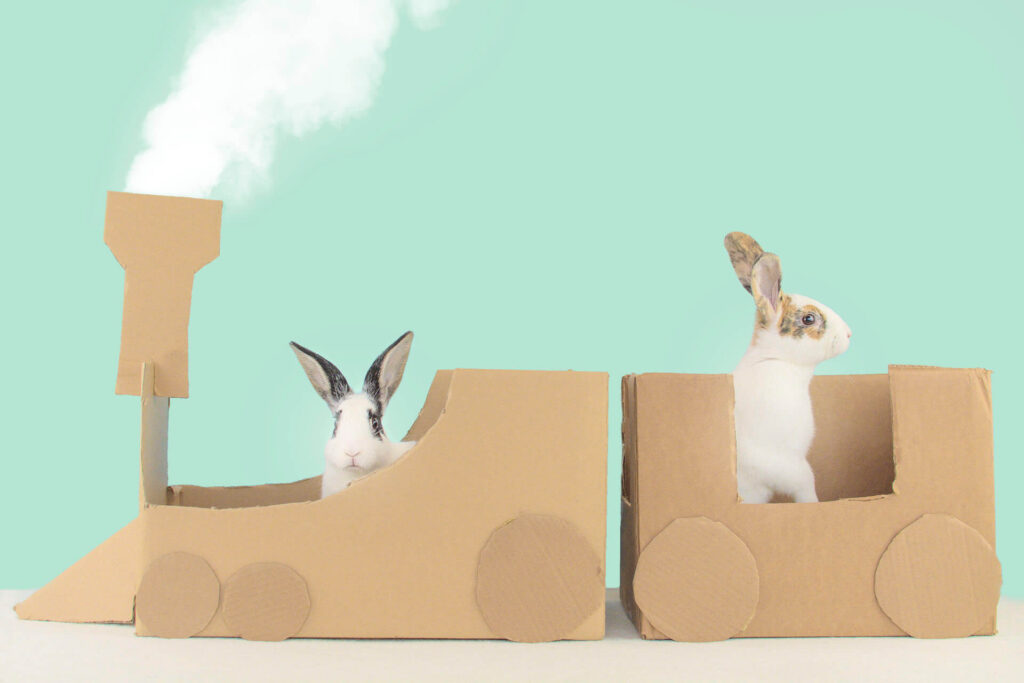My most treasured photograph of Finnegan is one I captured during his midday nap on the cool tile floor in our upstairs bathroom. Technically, it’s not a great photo. It doesn’t follow the rule of thirds, it isn’t very well-framed, and I somehow managed to nail the focus exactly where I didn’t want it: the shower curtain. Even so, it’s the photo of him I cherish most, and the one I share when people ask me what it’s like to live with a house rabbit. I was honored he felt comfortable enough in our home to relax and claim territory, and I took that photo so I can always remember his wonderfully quirky personality. We still refer to that bathroom in our old house as Finnegan’s.
What makes a photograph great isn’t always how polished it looks. Sometimes it’s simply a memorable occasion or one that best tells a story. If you’re lucky, it’s all of those things. Taking great photographs of your own rabbit or rabbits in need of homes at your local shelter means thinking beyond camera settings and composition. A beautifully exposed photograph of a rabbit trying to hide from you isn’t one that’s likely to impress friends or potential adopters. The trick to taking great rabbit photos is to create an environment in which you and your rabbit are comfortable. Rabbits will never share your interest in photography, so you’ll have to adjust your workflow in a way that brings out their inner supermodel.

The Environmental Portrait
The best way to photograph a rabbit is in the environment in which they’re most comfortable: their home. The less aware your rabbit is of you and your camera, the more relaxed they’ll be, and the less you manipulate their world, the more natural the photograph will look. Unfortunately, that’s also often the hardest way to photograph a rabbit, since their preferred environment is usually underneath a hidey box tucked away in a dark corner of your home. Rabbits are territorial, and it’s important to respect their space, as the price for disturbing a rabbit in their safe spot may be lost trust.
You’ll get better results when your rabbit comes out into the shared spaces in your home to play. Pull back the curtains to allow natural sunlight into the room and place your rabbit’s favorite treats and toys where you want them to sit while you position yourself far enough away to not interrupt your rabbit’s playtime. Be patient. Those animal-oriented television specials narrated by David Attenborough take weeks to film, so don’t let yourself get frustrated if you’ve been sitting for five whole minutes before something happens. Rabbits like to observe an environment before venturing into it, but they usually will when they feel comfortable.
Make sure you have the light you need to capture the image you want. If the light from the windows isn’t enough, consider turning on some of the lamps in your home. Just be aware that the bulbs in those lamps often give off a warm, yellow glow, which can create a color cast on your rabbit or in your scene. Or, you may find that the direct sunlight from opening the blinds is creating harsh shadows. If it makes you squint, it’s probably too bright. Indirect light (sunlight at an oblique angle to your window), or an overcast sky that diffuses sunlight, often works best. You can also try taking photos at different times of the day or, for cameras with manual settings, bump up your ISO to help freeze action. If you’re using a dSLR or mirrorless system, choose a “fast” lens with a wide aperture. I typically use a 35mm lens at f/5 on a cropped sensor dSLR camera system to capture rabbit photographs. Every camera system is different, so don’t be afraid to experiment.

The Studio Portrait
One advantage of setting up a photography studio is that you can control the lighting and the environment to highlight a rabbit’s features without a distracting background. However, you’re also removing all of those creature comforts that helped your rabbit relax in your environmental portraits. Most important is to maintain the safety of your rabbit. It’s often helpful to have a bunny-savvy assistant who can be close enough to rescue the rabbit if they try to run off the table or surface they’re on, leaving you able to focus on your photography.
Also, don’t make your rabbit sit near the bright, potentially hot lights for more than a couple of minutes. The good news is that most rabbits will tolerate them long enough for you to snap a few photos if you distract them with something they like, such as a piece of banana or cilantro. The more engaged and comfortable the rabbit looks in your photos, the more people who aren’t familiar with rabbits will be able to relate to them. The images I chose to share were those in which the rabbit was standing with their head held high, looking straight into the camera (head slightly to the side), eating treats, or playing with toys. Rabbits have large personalities and are easy to fall in love with—I wanted people to see that! If your rabbit is giving you a view of their posterior, or loafing with their chin on the table, try offering a treat.
If you’re going to invest in lighting designed for photography, a continuous lighting system works best (soft boxes or umbrellas). Using a flash or strobes of any kind will scare your rabbit and, while you might get away with one shot, repeated shots will cause your rabbit to hide, close their eyes, or even jump off your table. It’s not worth the risk and won’t give you the results you want.
Wrapping paper can make a great, cheap background as long as it’s not the shiny kind that will create reflections from your lights. I have often rooted through dollar stores to collect colorful rolls because let’s face it, supermodels find paper tasty and you might need to replace it. Fabric also works, but you’ll need to spend time ironing it before every shoot and secure it in a way that doesn’t cause distracting folds in your images. You can secure paper or fabric to a wall with thumbtacks or heavy tape and drape it across the table where your bunny sits to create a seamless background.
Make sure any props you use are bunny-safe. If you’re photographing rabbits for a shelter, your images will be seen by potential adopters who may assume the props are appropriate for rabbits to play with or chew. Be mindful what you select is not only safe for the shoot but also sets a good example for new bunny guardians.
If you’re skilled using an image editor, you can add props or words digitally. Avoid clothing your rabbit, though, as it’s often restrictive and uncomfortable for them. Making rabbits look like dolls or toys sends the wrong message about how to engage with them, especially for children. Remember: your photos are educational for people unfamiliar with rabbits.

Any camera will do.
One of the truly great things about photography in the 21st century is that it’s largely democratic. You likely already carry around a perfectly capable camera on your mobile device. If you’re looking for memorable, candid shots, you often can’t do better than the camera you already have with you. It’s also the quickest way to share the photos you take. Whether you have a state-of-the-art mirrorless system or just an old generation phone camera, you can create great rabbit photography at your fingertips. Just make sure to put your rabbit first. Nobody likes the paparazzi. Not even rabbits.
Reviewed by HRS staff
Author: Sandy ParshallPhoto Credit: Sandy Parshall
Journal Issue: House Rabbit Journal, Summer 2020





